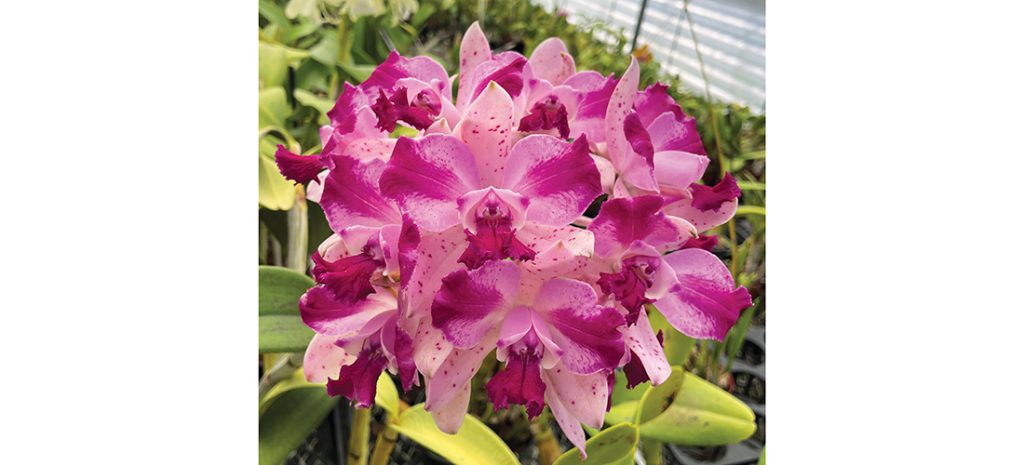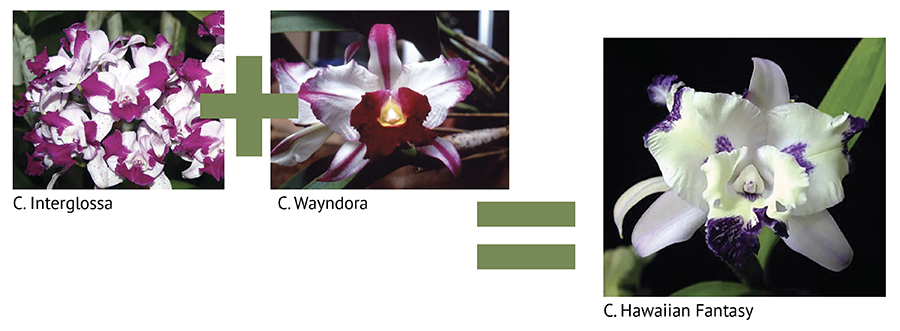What’s in a Name?

Cattleya Penny Kuroda and Cattleya Hawaiian Fantasy: Two Splash-Petal Enigmas
By Jason Harpster

What if your birth certificate was wrong? Yikes! You need it to get married, register for school, obtain a driver’s license or a passport. It verifies your age and citizenship. If it’s not the most important document you have sitting in your safety deposit box, it’s in the top three. But if a flower has a mistaken “birth certificate” it’s no big deal, right? This isn’t Little Shop of Horrors. It’s not like you’re going see Audrey II in line behind you at the DMV.
Just as the DMV tracks names and addresses for drivers, Kew Royal Botanical Gardens maintains the Kew World Monocot Checklist, which tracks currently accepted names for over 30,000 orchid species in the wild. The Royal Horticultural Society is the international authority for orchid hybrids and maintains the International Orchid Register that lists over 100,000 orchid hybrids with their seed and pollen parents. Orchid hybrids must be registered to be eligible for shows and awards.
In her article “Cattleya Penny Kuroda By Any Other Name,” published in the April 2014 issue of Orchids, Laura Newton details how Cattleya (C.) Penny Kuroda was originally registered with the wrong parentage. When C. Penny Kuroda was registered in 1976 by Mary Hernlund, the parents were listed as C. Summer Snow x C. guttata. Given that virtually all splash-petal cattleyas have C. intermedia var. aquinii in their background, Newton rightfully questioned where the distinct, peloric, splashed petals of C. Penny Kuroda and its progeny originated. The Royal Horticultural Society found Newton’s argument convincing and subsequently updated the registration to C. Summer Stars x C. guttata that year.
Michael Blietz, an accomplished Hawaiian orchid grower, has uncovered new evidence that shows the registration change for C. Penny Kuroda is incorrect. In his letter to the American Orchid Society in February 2022, Blietz recounts how he recently received the cross book from the Mary Hernlund nursery which shows the parents of C. Penny Kuroda as C. Summer Snow x C. guttata var. alba. Interestingly, the alba form of C. guttata was not found until the early 2000s; only C. tigrina var. alba would have been available in 1976.
After reviewing the many progeny of C. Penny Kuroda and the inventory from Hernlund’s stud book, Blietz concluded that the color, splashing and spots exhibited could only come from C. Interglossa, not C. Summer Snow or C. Summer Stars as Newton espoused. It is not a coincidence that all of the selfings and original plants from the C. Penny Kuroda were bifoliate due to the influence of C. amethystoglossa, C. intermedia, and C. tigrina which are all bifoliate species. The size of the spots and lavender color on the tips of the side lobes of the lip are in line with C. amethystoglossa and its hybrids. The size and length of the splashes on C. Penny Kuroda also match C. Interglossa since the peloric petals are mirroring the color and pattern on the lip.
Prior to the registration change of C. Penny Kuroda in 2014, C. Summer Snow had five F1 offspring with C. Penny Kuroda, by far being the most prolific with 143 F1 offspring and 837 total progeny. A closer examination of C. Summer Snow’s offspring is warranted as it appears a registration error similar to that for C. Penny Kuroda has occurred with C. Hawaiian Fantasy, another prolific splash-petal hybrid with 25 F1 offspring and 114 total progeny as of this writing.
Cattleya Penny Kuroda was registered in 1976 by Hawaiian grower Mary Hernlund while C. Hawaiian Fantasy was registered by Benjamin Kodama of Waianae, Hawaii in 1982. The parents of C. Hawaiian Fantasy are listed as C. Summer Snow x C. Wayndora, though this registration is suspect as neither parent has C. intermedia in their background. Unfortunately, Kodama passed away in 2017, which makes determining the exact parentage of C. Hawaiian Fantasy exceedingly difficult. An attempt to obtain clarification from Kodama Orchids has not been successful.
Correspondence with Roy Tokunaga from H&R Orchids, another longtime orchid grower and breeder in Oahu, in December of 2021 was especially helpful. Tokunaga confirmed that he and other older Hawaiian growers knew C. Hawaiian Fantasy had C. intermedia var. aquinii in its background, though they were unsure of the exact parentage. These hybridizers understood that the peloric form of C. intermedia var. aquinii is dominant and passed on to its progeny.
In discussing Newton’s findings regarding the correct parentage of C. Penny Kuroda and how this would relate to the lineage of C. Hawaiian Fantasy with Tokunaga and Fred Clarke, both gentlemen agreed that the current registration for C. Hawaiian Fantasy is incorrect. The question then becomes what, if anything, should be done about the incorrect registration?
Reviewing Hernlund’s cross book reveals another curious surprise: C. Hawaiian Fantasy and its reciprocal cross were made by Hernlund. Despite being registered by Kodama in 1982, it appears Hernlund made, or at least attempted to create, C. Hawaiian Fantasy as detailed by crosses No. 1247 and 1257. Blietz reached out to Ben Kodama Jr. who confirmed that his father, Benjamin Kodama Sr., received the C. Hawaiian Fantasy flasks from a grower on the Big Island. Blietz agrees that these plants had to come from Hernlund.
Although it is impossible to prove with 100 percent certainty that C. Interglossa is the correct parent of C. Penny Kuroda and C. Hawaiian Fantasy, we can conclude that the registrations for both hybrids are incorrect as C. Summer Snow does not have C. intermedia in its genetic background. It is unlikely that C. Summer Stars is in the background of either of these crosses since Stewart Orchids used alba parents to create C. Summer Stars. Considering the state of hybridizing in Hawaii during the 1970s and ’80s and the push to bring new crosses to market before they were registered, it is easy to see how these errors occurred. Given the new evidence that has come to light since 2014 when the Royal Horticultural Society revised the parentage of C. Penny Kuroda from C. Summer Snow x C. guttata to C. Summer Stars x C. guttata, the registration should be updated to C. Interglossa x C. tigrina, or, alternatively, change the C. Summer Snow parentage to unknown. Moreover, the registration for C. Hawaiian Fantasy should also be updated accordingly since the same parent was used to make C. Penny Kuroda.
Correcting the record and establishing the proper lineage helps honor the numerous contributions of Hernlund, Kodama, Tokunaga and other Hawaiian growers. Thanks to the Hernlunds’ cross journal and Ben Kodama Jr., we know that Hernlund used C. Summer Snow to make both C. Penny Kuroda and C. Hawaiian Fantasy. Blietz agrees that Hernlund’s stud plant that was labeled C. Summer Snow was mislabeled and was actually C. Interglossa. Updating the registrations of C. Penny Kuroda and C. Hawaiian Fantasy would highlight the contributions of this Hawaiian community and ensure that the knowledge they shared is not lost. Mary Hernlund passed away on April 19, 2022 at the age of 103. PS
Jason Harpster is an accredited American Orchid Society judge and works at his family’s business, Central Security Systems. He hopes to share his collection of 2,000-plus orchids by starting a botanical garden in Southern Pines.
